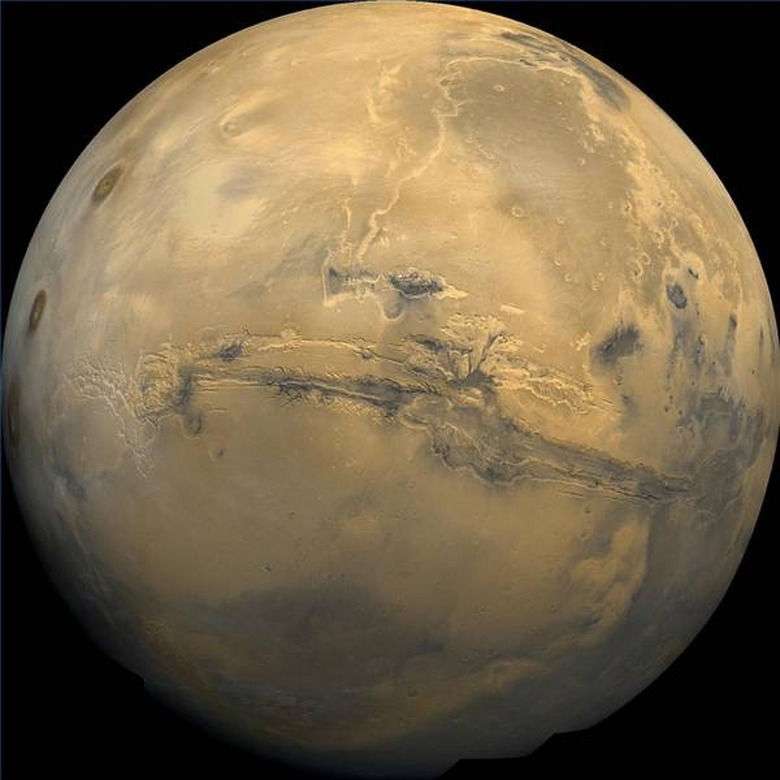What Is Mercury's Rotation Period?
Mercury is the closest planet to the Sun. It is a difficult planet to observe because of its proximity to the star, with the only times to see it with the naked eye being right before dawn and right after sunset. For this reason, relatively little is known about Mercury, despite the fact that it is closer to Earth than planets such as Jupiter and Saturn. For decades, the rotational period of Mercury was thought to equal the length of time it took to orbit the Sun, but scientists now know this is not the case.
Tidally Locked
Tidally Locked
It was once assumed that Mercury was tidally locked to the Sun and took the same number of days to rotate on its axis once as it did to orbit the Sun–a period of 88 Earth days. Tidal locking is an astronomical term that describes a heavenly body that revolves around another body with one side always facing the body it is orbiting. For example, the Moon is tidally locked to the Earth because the amount of time it takes to revolve around the Earth is the same amount of time it needs to rotate on its own axis. This means that the Moon will always have the same side facing the Earth as it orbits the planet. It was not until 1965 that radar observations of Mercury proved that it was not tidally locked to the Sun.
3:2 Spin-orbit Resonance
3:2 Spin-orbit Resonance
The 1965 observations showed that Mercury completes one of its rotations in 58.65 Earth days. This figure is two-thirds of the time that Mercury takes to complete one orbit of the Sun. Astronomers use the term "spin-orbit resonance" to describe the ratio of a rotation on a planet's axis to the time it needs to complete an orbit of the Sun. Therefore, Mercury has a spin-orbit resonance of 3:2. In what would amount to two years on Mercury–a span of about 176 Earth days–the planet will have completed three rotations on its axis.
Solar day on Mercury
Solar day on Mercury
A solar day is the amount of time it takes for the Sun to next pass the noon point in the sky. A solar day on planet Earth takes a little under 24 hours. However, on Mercury a completed solar day would last for 175.85 Earth days. This time frame represents the amount of Earth days it takes for Mercury to orbit the Sun twice, or two Mercurial years.
Strange Effect
Strange Effect
If someone could observe the Sun from Mercury, that person would watch the Sun pass from east to west. However, the Sun would then appear as if it were stopping for a moment and then it would reverse direction for a while before once again heading back on its east to west path. This is because Mercury does not possess a circular orbit but a more elliptical type of orbit. When Mercury is closest to the Sun, the planet speeds up due to the stronger gravitational pull of the star. The velocity of Mercury around the Sun then becomes quicker than the speed with which it turns on its axis, producing this strange effect.
Mercury's Temperature
Mercury's Temperature
Astronomers used to think that one hemisphere of Mercury was always incredibly hot, while the other one was always remarkably cold, since they believed that only one side always faced the Sun. Mercury has no atmosphere to speak of, so the side that is facing the Sun at any one time is hot, with temperatures capable of reaching 840 degrees Fahrenheit, while the other side of the planet facing away from the Sun plummets to minus 300 degrees Fahrenheit. Since the planet does have the rotational period of 58.65 days, the surface of Mercury is eventually exposed to both extremes.
Cite This Article
MLA
Lindell, John. "What Is Mercury's Rotation Period?" sciencing.com, https://www.sciencing.com/what-mercurys-rotation-period-4760198/. 24 April 2017.
APA
Lindell, John. (2017, April 24). What Is Mercury's Rotation Period?. sciencing.com. Retrieved from https://www.sciencing.com/what-mercurys-rotation-period-4760198/
Chicago
Lindell, John. What Is Mercury's Rotation Period? last modified March 24, 2022. https://www.sciencing.com/what-mercurys-rotation-period-4760198/
